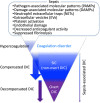The pathophysiology, diagnosis, and management of sepsis-associated disseminated intravascular coagulation
- PMID: 37221630
- PMCID: PMC10202753
- DOI: 10.1186/s40560-023-00672-5
The pathophysiology, diagnosis, and management of sepsis-associated disseminated intravascular coagulation
Abstract
Background: The International Society on Thrombosis and Haemostasis (ISTH) released overt disseminated intravascular coagulation (DIC) diagnostic criteria in 2001. Since then, DIC has been understood as the end-stage consumptive coagulopathy and not the therapeutic target. However, DIC is not merely a decompensated coagulation disorder, but also includes early stages with systemic activation in coagulation. Thus, the ISTH has recently released sepsis-induced coagulopathy (SIC) criteria that can diagnose compensated-phase of coagulopathy with readily available biomarkers.
Main body: DIC is a laboratory-based diagnosis due to various critical conditions, although sepsis is the most common underlying disease. The pathophysiology of sepsis-associated DIC is multifactorial, and in addition to coagulation activation with suppressed fibrinolysis, multiple inflammatory responses are initiated by activated leukocytes, platelets, and vascular endothelial cells as part of thromboinflammation. Although overt DIC diagnostic criteria were established by ISTH to diagnose the advanced stage of DIC, additional criteria that can detect an earlier stage of DIC were needed for potential therapeutic considerations. Accordingly, the ISTH introduced SIC criteria in 2019 that are easy to use and require only platelet count, prothrombin time-international normalized ratio, and Sequential Organ Failure Assessment Score. SIC score can be used to evaluate disease severity and determine the timing of potential therapeutic interventions. One of the major disadvantages in treating sepsis-associated DIC is the lack of availability of specific therapeutic approaches beyond treating the underlying infection. Clinical trials to date have failed because included patients who were not coagulopathic. Nevertheless, in addition to infection control, anticoagulant therapy will be the choice for sepsis-associated DIC. Therefore, the efficacy of heparin, antithrombin, and recombinant thrombomodulin has to be proven in future clinical studies.
Conclusion: It is necessary to develop a novel therapeutic strategy against sepsis-associated DIC and improve the outcomes. Consequently, we recommend screening and monitoring DIC using SIC scoring system.
Keywords: Antithrombin; Coagulopathy; Disseminated intravascular coagulation; Endothelial cell; Sepsis; Thrombomodulin.
© 2023. The Author(s).
Conflict of interest statement
TI has participated in advisory boards of Japan Blood Products Organization, Toray Medical, and Asahi Kasei Pharmaceuticals and received a research grant from JIMRO. JH has received honoraria from Diagnostica Stago, Pfizer PFE France and Sanofi Aventis France, MSD, Shionogi, and Inotrem. JMC has participated in scientific advisory boards and consulting from Abbott, Anthos, Alnylam, Bristol Myers Squibb, Five Prime Therapeutics, Pfizer, Takeda, and research funding from CSL Behring. JHL serves on the Steering Committees for Merck, Octapharma, and Werfen.
Figures




References
-
- Squizzato A, Gallo A, Levi M, Iba T, Levy JH, Erez O, Ten Cate H, Solh Z, Gando S, Vicente V, Di Nisio M. Underlying disorders of disseminated intravascular coagulation: communication from the ISTH SSC Subcommittees on Disseminated Intravascular Coagulation and Perioperative and Critical Care Thrombosis and Hemostasis. J Thromb Haemost. 2020;18(9):2400–2407. doi: 10.1111/jth.14946. - DOI - PubMed
Publication types
LinkOut - more resources
Full Text Sources

